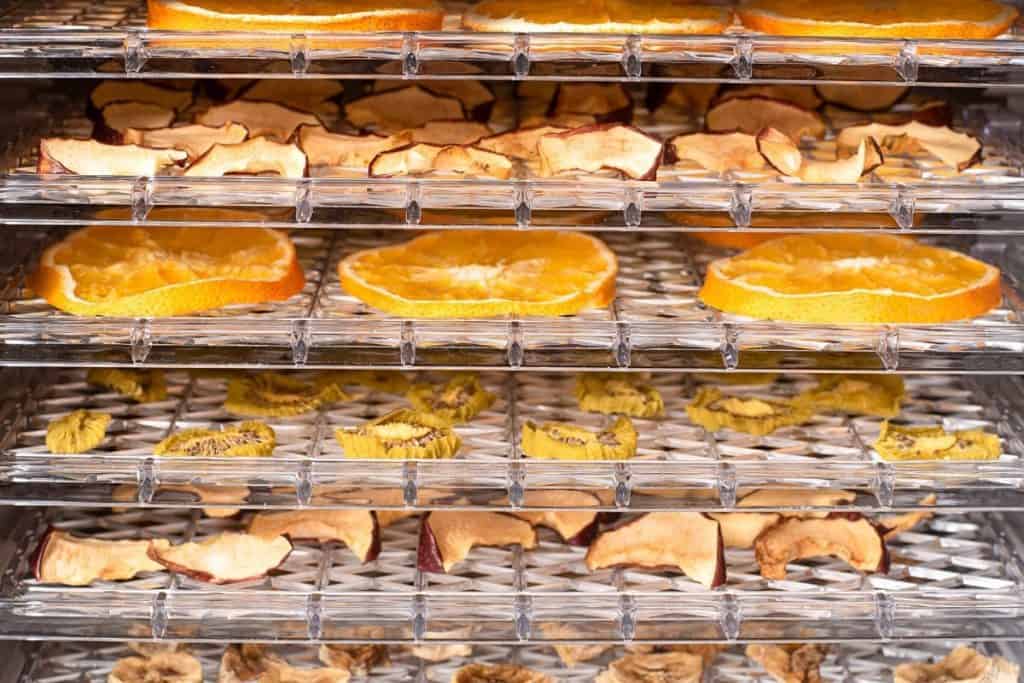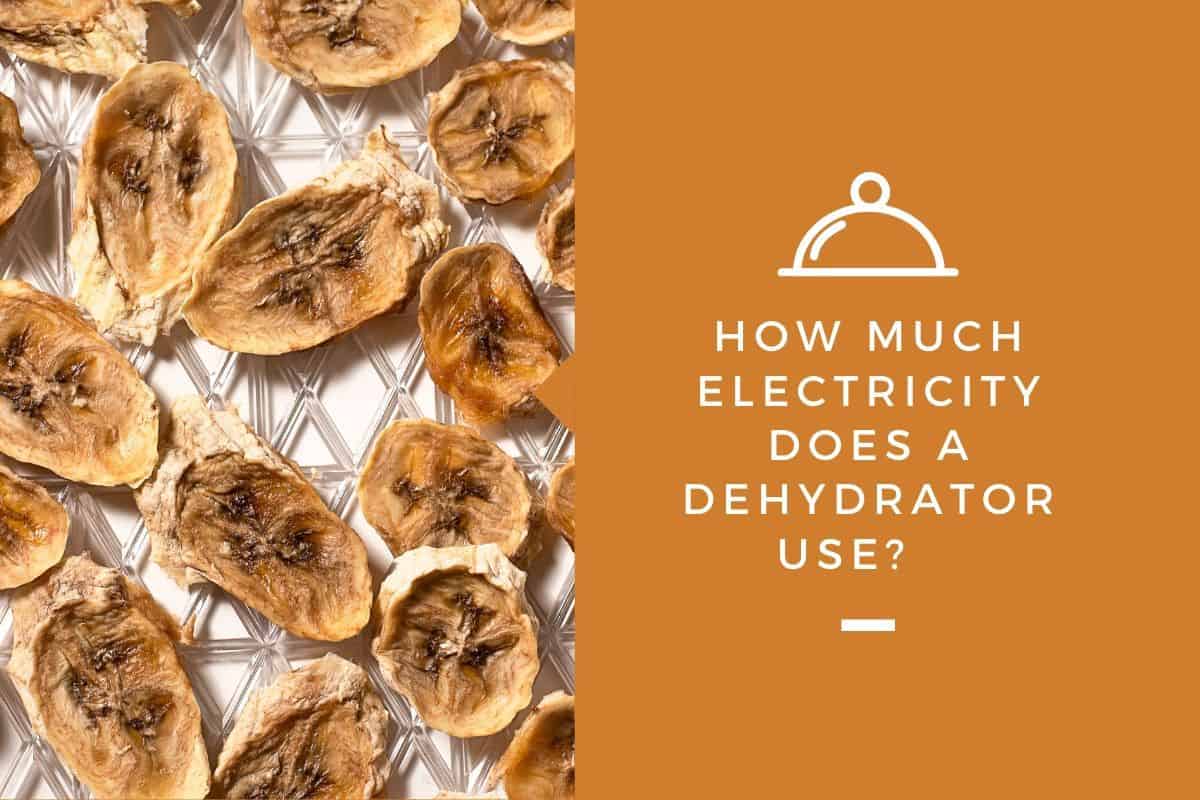A food dehydrator is a small kitchen appliance used to dry or dehydrate food, leading some to wonder how much electricity a dehydrator uses. Dehydrators use a light flow of hot air in order to reduce the amount of water found in fruits, vegetables, meats, and other foods.
This food dehydration keeps it from spoiling as quickly as it would without the water removed and significantly reduces the risk of bacteria growth that might otherwise take place if food remained fully hydrated.
So, how much electricity does a dehydrator use?
Running a dehydrator can cost anywhere between 0.04$ and 0.13$ per hour based on the average kWh rate of 13.19 cents in the USA. Sometimes dehydrators run for as long as 30+ hours, which wouldn’t cost more than 2-4$. Dehydrators operate primarily by utilizing a built-in fan and low amounts of heat to force the moisture out of the ingredients.
| Wattage | Time (h) | kWh | Total Cost |
| 1000 | 10 | 0.13$ | 1.31$ |
| 750 | 10 | 0.13$ | 0.97$ |
| 500 | 10 | 0.13$ | 0.65$ |
| 300 | 10 | 0.13$ | 0.39$ |
The table above shows us that even the most consuming dehydrator won’t cost more than a few dollars to run for a day or two. Dehydrators wouldn’t be a viable option if they were expensive to run since they’re supposed to run for such a long time.
Many believe that a food-dehydrator allows people to retain the vitamins and nutrients within their food in addition to being able to store and carry it more easily with a minimal amount of electricity use.
Read on to find out how food dehydrators work and how much electricity they actually use.
How a Dehydrator Works
Food drying, or dehydration, has been used as a method of preserving fruit, vegetables, and meat for centuries. The water content in most foods is very high; many fruits and vegetables are over 80% water, and various meats can be made up of over 50% water.
Using a food dehydrator to remove moisture and reduce the water content in foods provides the following benefits:
- Limits and restrains various bacteria from growing and therefore spoiling food
- Significantly reduces the weight of food
- Preserves and extends the shelf life of many foods
- Preserves nutrient content and taste of foods
Food dehydrators work by using heat and airflow to remove moisture from food. Most individual kitchen appliance dehydrators use electricity to operate a heating element that warms the food placed on drying trays and causes moisture to be released from inside.
Then an electric fan operates to blow the warmed and moist air out of the appliance through air vents. This combination of heat and airflow allows the dehydration process of food to take place.
Generally, the goal of food dehydration is to significantly lower the water content to less than 20% for most foods. Application of constant temperature and adequate airflow are both needed to achieve this.
Too much heat or fluctuation in temperature can result in hardened rather than dehydrated food—food that is hard and dry on the outside but moist and susceptible to spoiling on the inside. Inadequate airflow inhibits the release of moisture within the food and interferes with the dehydration process.
Dehydrators and Electricity
Many people consider dehydrators to be a useful kitchen appliance, despite the fact that most of them use electricity. Since most consumers use electric dehydrators to save money and waste less food, especially when it comes to fruits and vegetables, there is a concern that the cost of running this appliance exceeds the benefits and savings.
Dehydrated Foodz estimates that most food dehydrators cost between $0.30 and $1.20 to operate during a ten-hour period. The actual cost of electricity depends on the size and features included when it comes to each dehydrator model.
For example, some dehydrators are more energy-efficient and include features that conserve electricity. Some of these features are:
- Internal regulators to turn off the fan and heater periodically while retaining heat
- Temperature control settings
- Removable trays to adjust space for the amount of food being dried
Some dehydrators utilize more electricity due to their size and/or how long they run. Therefore, if you are weighing options as to your plans to dehydrate foods against the amount it will cost to run the dehydrator, then it’s best to consider the efficiency of available models and choose one with appropriate features.
For those consumers who wish to dry large amounts of food frequently, it might be wise to invest in a bigger and more advanced dehydrator.
Overall, even when it comes to electricity usage, having a dehydrator as part of your kitchen equipment is considered a cost-effective way to preserve foods that would otherwise tend to spoil quickly, creating more savings and less waste.
Dehydrators and Foods

As more people become familiar with the benefits of food dehydration, they might wonder which foods would work with a dehydrator. There are many online recipes and suggestions for those looking into the versatility of dehydrated foods and how to reduce food waste.
Some foods that are paired well with dehydrators include:
- Meat for making beef jerky
- Bananas for making banana chips
- Leftover vegetables such as potatoes, turnips, mushrooms, kale, etc., for making vegetable chips
- Apples
- Seasonal fruits such as melons or mangoes
Preparing foods and dehydrating them does take time and energy. However, dehydrated foods can generally last for a month or more, depending on the food, if stored properly in an airtight container in a cool and dark space.
Non-Electric Dehydrator Options vs. Electric Dehydrators
There are some non-electric dehydrator options such as a solar dryer. Solar drying is different from “sun drying,” a method of food dehydration utilizing direct sun and open air that has been used for far longer than electricity or harnessed solar power has been around.
However, this process of drying food in the open through heat from the sun is unpredictable and imprecise, as well as potentially dangerous due to leaving food vulnerable to insects, birds, and other animals.
Such variations in outside temperature and airflow can have an adverse effect and actually alter foods at a chemical level.
Solar Dehydrators
Solar food dryers operate by using clear glazing on the outside of the unit to allow sunlight to enter an enclosed chamber with a dark interior surface where it’s converted to heat.
The airflow is generated through natural convection in which the warm air rises, and vents are adjustable to regulate both airflow and temperature.
Solar-powered dehydrators are effective and practical wherever sunlight is moderately plentiful. In fact, solar food dehydrators are considered by many to be an excellent option when it comes to future agricultural sustainability and food security.
However, this would be on a larger commercial or industrial scale.
Electric vs. Solar Dehydrators
Some consumers may wonder whether electric or solar dehydrators are better. For individual use, electric dehydrators are more expensive than their solar counterparts due to the manufacturing materials, cost of electrical circuits, and digital programming controls.
However, when it comes to efficiency and dehydration times, they are significantly reduced with electric models compared to solar dehydrators.
This is because of the continuous nature of the drying process with electric appliances through the power of the heater and fan units, as well as the volume of airflow.
Therefore, although the cost of an electric dehydrator is higher at the outset and generates utility costs through electricity in use, it’s a better choice as a kitchen appliance than a solar food dryer.
Electric dehydrators, in general, run at low temperatures, use marginal levels of power, and are quite energy-efficient, making them a good choice even for the cost of electricity when in use.

